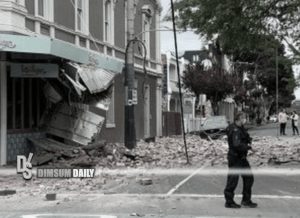

By: Patrick Hatch, Simone Fox Koob
and Dominic Powell
Victoria will be rattled by potentially significant aftershocks in coming weeks and months after the largest earthquake recorded in the state damaged buildings in inner-Melbourne and was felt across south-eastern Australia.
Authorities said it was fortunate the magnitude-5.9 earthquake hit a largely unpopulated area north-east of Melbourne at 9.15am on Wednesday, and that the normally busy Chapel Street in Windsor was empty when tremors caused a restaurant to partly collapse onto the footpath below.
“Certainly, it could have been a lot worse in Chapel Street today if it had been a busy Saturday morning,” Victoria State Emergency Service chief officer Tim Wiebusch said.
Repair work to make damaged buildings safe is permitted under the state’s construction shutdown.
The quake was recorded between Mansfield and Rawson, about 130 kilometres north-east of Melbourne at a depth of 10 kilometres and lasted 30 to 40 seconds, according to Geoscience Australia. There were six aftershocks through the day, of magnitudes 3.5, 4.1, 2.5, 3.1, 2.4 and 2.9.
Emergency Management Commissioner Andrew Crisp said the emergency services had more than 100 calls for help, including 55 in metropolitan Melbourne, mostly for minor structural damage, but there were no reported injuries.
“There will be aftershocks … and we’re likely to see those for weeks and even months,” Mr Crisp said.
“It’s unlikely that we’ll see aftershocks that will equal or exceed what we saw at 9.15 this morning. However, there is still a chance of significant aftershocks.”
Betty’s Burgers & Concrete Co restaurant in Chapel Street, Windsor, was one of the most significantly damaged buildings in the state, partly collapsing when the earthquake rippled through the city.
The restaurant’s managing director, Troy Mcdonagh, said nobody was inside when the earthquake hit, about an hour before employees were due to start work.
“No one walking past was hurt,” he said. “Now we are waiting for the damage to be assessed.”
‘Like a bomb’
Kim Hong was in the kitchen at Nguyen’s Hot Bread, across the road from Betty’s Burgers, when she felt what she thought was an explosion.
“The kitchen, when I was cooking, was wobbling. Oil was coming up from the fryer, making a fire. I thought my kitchen was going to explode,” she said.
She rushed outside where there was “smoke everywhere” and people running away from the partially collapsed burger outlet.
“I thought the building had exploded, like someone had put a bomb there,” she said.
The facade of a Coles supermarket 600 metres down Chapel Street in Prahran also partially collapsed, as did a building front on Brunswick Street, Fitzroy, the SES said.
The emergency service did not see any significant infrastructure damage, and other calls for assistance mostly related to minor structural damage such as chimney collapses at homes.
Any residents who suffered damage to their property because of the quake should have it checked by a licensed builder, which was permitted under COVID restrictions, said Mr Wiebusch.
Master Builders Victoria also confirmed that any work to make buildings safe is permitted.
About 35,000 electricity customers lost power after the quake, and almost 1000 were still without power by 1pm.
In the regions, the Ambulance Victoria dispatch bay in Mansfield reported damage, while Beechworth hospital lost power and was operating on a backup generator.
Geoscience Australia first reported the quake as magnitude 6 before revising that to 5.8 and then 5.9, making it the largest on-land quake recorded in Victoria.
The largest on-land earthquake recorded in Australia was the magnitude-6.5 one that hit Meckering in Western Australia in 1968.
Marc Colella, the global head of building engineering at consultancy firm Aecom, said Victoria’s heritage buildings with brick facades were the most vulnerable to earthquake damage and the most likely to injure bystanders.
“Most injuries and fatalities are typically from those type of buildings that collapse on innocent bystanders,” Mr Colella said, adding skyscrapers were more resilient.
“Design guidelines here have always been trailing the rest of the world, where there is a greater history of seismic events, places such as New Zealand.”
The last major earthquake-induced change to Australia’s planning code was in response to the devastating 1989 Newcastle quake, after which a 1994 update required buildings to be more resilient.
‘Panic button’
Trevor Carstein, manager of the Licola Wilderness Village school camp at Licola, near the earthquake epicentre, said he and his wife and two sons, aged 13 and 19, “all sort of hit the panic button”.
“It broke our bedroom window and kitchen window,” he said. “We looked outside and all the trees were shaking and the buildings across the road were moving. And I could actually see the road in front of the house moving.”
At Mount Buller, also near the earthquake’s epicentre, Rhylla Morgan said the mountain had a “very solid shake” but there was no risk of avalanche.
“But certainly, the whole mountain got a very solid shake. We could feel it for a good 30 seconds, and then we felt the aftershock a bit later,” said Ms Morgan, the spokeswoman for Buller Ski Lifts.
“People were skiing at the time, and they are back skiing now.“
 Al-anwar Newspaper English news in Australia
Al-anwar Newspaper English news in Australia